人教版八年级下册英语课件《Unit7Section A 3 (Grammar focus -4c》
- 格式:ppt
- 大小:1.49 MB
- 文档页数:33
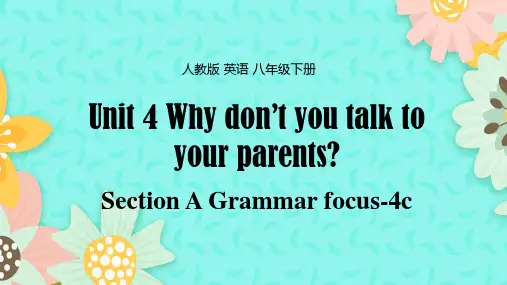


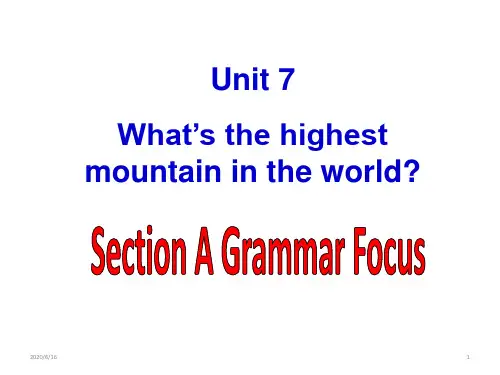
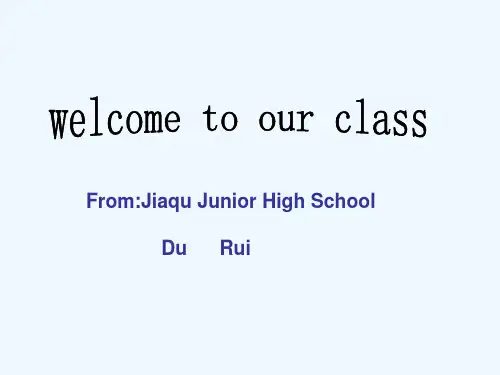
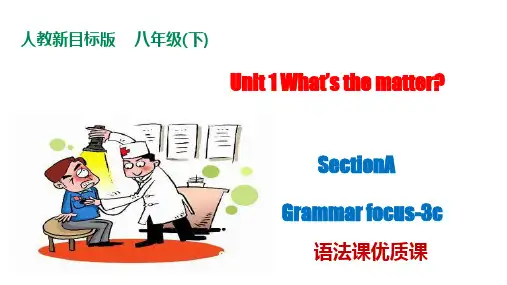
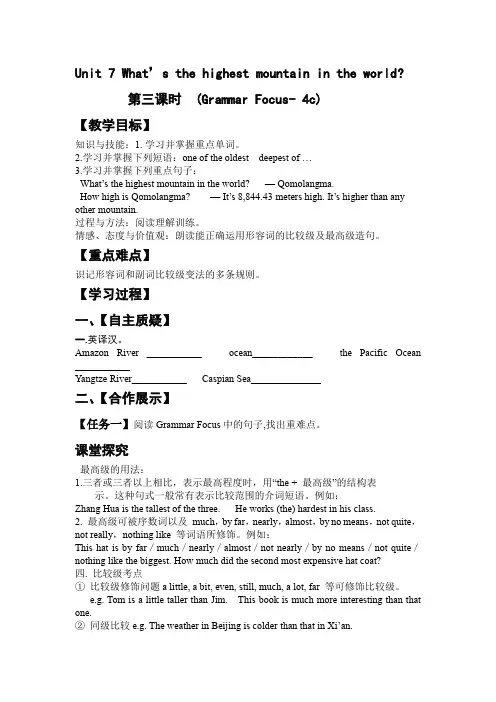
Unit 7 What’s the highest mountain in the world?第三课时 (Grammar Focus- 4c)【教学目标】知识与技能:1.学习并掌握重点单词。
2.学习并掌握下列短语:one of the oldest deepest of …3.学习并掌握下列重点句子:What’s the highest mountain in the world? — Qomolangma.How high is Qomolangma? — It’s 8,844.43 meters high. It’s higher than any other mountain.过程与方法:阅读理解训练。
情感、态度与价值观:朗读能正确运用形容词的比较级及最高级造句。
【重点难点】识记形容词和副词比较级变法的多条规则。
【学习过程】一、【自主质疑】一.英译汉。
Amazon River ___________ ocean____________ the Pacific Ocean ___________Yangtze River___________ Caspian Sea______________二、【合作展示】【任务一】阅读Grammar Focus中的句子,找出重难点。
课堂探究最高级的用法:1.三者或三者以上相比,表示最高程度时,用“the + 最高级”的结构表示。
这种句式一般常有表示比较范围的介词短语。
例如:Zhang Hua is the tallest of the three. He works (the) hardest in his class.2. 最高级可被序数词以及much,by far,nearly,almost,by no means,not quite,not really,nothing like 等词语所修饰。
例如:This hat is by far/much/nearly/almost/not nearly/by no means/not quite/nothing like the biggest. How much did the second most expensive hat coat?四. 比较级考点①比较级修饰问题a little, a bit, even, still, much, a lot, far 等可修饰比较级。
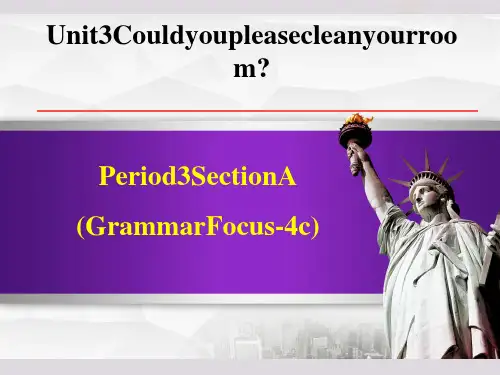
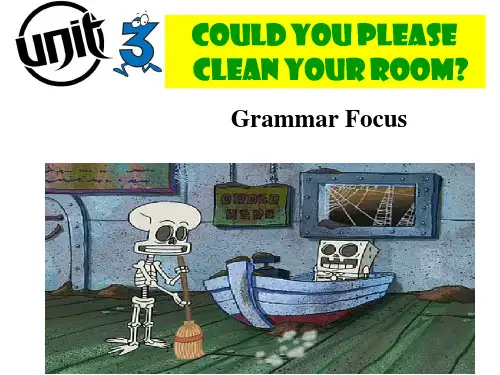
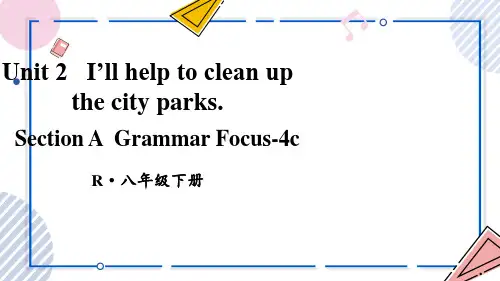
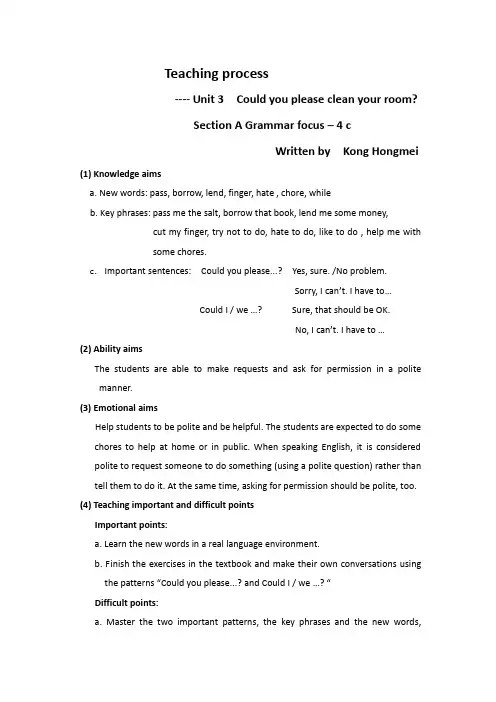
Teaching process---- Unit 3 Could you please clean your room?Section A Grammar focus – 4 cWritten by Kong Hongmei(1) Knowledge aimsa. New words: pass, borrow, lend, finger, hate , chore, whileb. Key phrases: pass me the salt, borrow that book, lend me some money,cut my finger, try not to do, hate to do, like to do , help me withsome chores.c. Important sentences: Could you please...? Yes, sure. /No problem.Sorry, I can’t. I have to…Could I / we …? Sure, that should be OK.No, I can’t. I have to …(2) Ability aimsThe students are able to make requests and ask for permission in a polite manner.(3) Emotional aimsHelp students to be polite and be helpful. The students are expected to do some chores to help at home or in public. When speaking English, it is considered polite to request someone to do something (using a polite question) rather than tell them to do it. At the same time, asking for permission should be polite, too.(4) Teaching important and difficult pointsImportant points:a. Learn the new words in a real language environment.b. Finish the exercises in the textbook and make their own conversations usingthe patterns “Could you please...? and Could I / we …? “Difficult points:a. Master the two important patterns, the key phrases and the new words,especially the differences between “borrow “ and “ lend”.b. According to the real language environment, use “Could you please …?”or“Could I /we … ?”to make conversations about requests and permissionTeaching stepsStep1Preparation(1) Watch a video “work at home “to lead in this lesson and to relax and intereststudents. Students can sing along with it if they can.(2) Ask some students to help the teacher do some chores in the classroom. Doingthis is to revise the pattern ”Could you please …?and teach the new words “pass, lend, borrow, chore, finger” in real language environment.(3)Show six pictures and ask the students to make conversations with teachertogether to revise the pattern “Could you please …? and the different answers to the requests, meanwhile, revise the phrases about housework in the last lessons , such as “taking out the rubbish, sweeping the floor, folding the clothes, making the bed, cleaning the living room, doing the dishes.” and so on. Step2 Presentation(1)Make sentences using “I like to do … because …”“ I hate to do …, because I…”to prepare for the conversation in 4 C.a. The teacher sets an example.b. Students practice in pairs and make their own sentences.c. Ask four students to show the class their sentences.(2) Show a picture of “watching a movie, doing some chores, and doing thehomework” on the blackboard.According to the picture to make a similar conversation in 4c. The teacher asks two students to do the conversations with her together in order to set examples for the whole class.Step 3 Practice(1)The teacher makes conversations with two students to give examples first:Begin with ”Could I ask you to help me with some chores?”, then use the pattern ”Could you please help me…?” to talk about what chores they can helpto make the conversation.b. Ask the other students to practice in pairs to make similar conversations.c. Ask two pairs to act out their conversations in front of the whole class.If they have done well, give them some big hands.(2)Finish 4C. Let the students do 4 C In their textbooks.(3)Check the answers together. Boys act as A, girls act as B to read theconversation aloud together. The right answers will be on the blackboard at the same time.Step4 Explanation.(1)Choose the four sentences using “Could you please…? Could I …?”and showthem on the blackboard, let students read them aloud. Then explain the two patterns about making requests and asking for permission.(2)Explanation. Tell students If they want to ask someone to help them, they coulduse the pattern “Could you please…? And the other may give them different answers, for example “Yes, sure. /No problem”. Or “Sorry, I can’t I have to…” If they want someone to allow them to do something, they could use the pattern “Could I/ we …?” and the answers may be “ Yes, that should be OK.’ Or “Sorry, you can’t. you have to …”(3)Tell students no matter they make requests or ask for permission, they should bepolite and be helpful.Step5. Practice(1) Ask students to practice the pattern “Could you please… ?a. Watch a piece of news about a group students who volunteer in an oldpeople’s home.b. Suppose they will go to an old people’s home tomorrow, ask what they can dofor the old people.c. Make conversations in pairs, using the pattern “Could you please… ? Encouragethem to try to make original conversations.d. Ask four pairs to show their conversations in class.(2) Ask the students to practice the pattern “Could I / we …?”a. Watch a video that is about a birthday party.b. Suppose next week is their birthday, they want to do something for theirbirthday, but they must ask their parents for permission first.c. Make conversations in pairs, using the pattern “Could I/ we…? Encouragethem to try to make original conversations.d. Ask four pairs to show their conversations in class.e. Show a picture about asking for permission on birthday.Students make conversations with the teacher together in order to lay stress the pattern “Could I/ we…?The teacher acts as the mother, the students act as the kid.Step 6 Production(1). Finish 4a. Ask the students to finish 4a in their textbooks, then check theanswers by asking a student to show her answers. If she has done well,give her big hands.(2). Finish 4c Work in group of four to do a surveya. Watch a piece of video of beautiful mountains to relax and prepare for 4 C;b.Show a picture of an travel company logo ” enjoy holiday”, the teacher hasturned into a tour guide and welcomed the students to “enjoy holiday”.c.Give two examples. The tour guide makes conversations with two groups ofstudents who want to have a good holiday in the coming summer vacation.The guide advises them to have a camping trip and helps them make a good plan. Use the pattern in 4C, then , the group leader gives a report.d. Let students have a discussion, make a list what they need to do for acamping trip, complete the chart in 4C, then the group leader gives a report. Step 7 ProgressFinally, it’s time to do some writing exercises, in this way, the students can have a deep memory about what they have learned in this class. This step can help students to summarize what they have learned.a.They should pay attention to the sentences in “Grammar focus”, read themaloud and try to remember them.b.Explain which sentences are for permission, which sentences are forrequests.plete the sentences in their exercise paper.d.Check the answers together.Step 8 SummaryThe students have learned much in this lesson, but they also need to have a short summary to revise what they have learned in this lesson, especially the new words and the two important patterns.Step 9 EmotionLiving in the society, manners are very important to us, students have learned how to ask for permission and make requests, and they should remember to be polite and helpful. So the sentence ‘’Manners make the man “is just for them.Step 10 HomeworkAs for homework, I let the students finish their exercise paper to revise the new words and patterns in this lesson. I think it’s easy for them and it’s not too much. After all, they need time to relax and rest after class.Step11 Blackboard DesignUnit 3 Section A 3 ( Grammar focus — 4c )New words:1.pass---passed2.lend—lent3.borrow—borrowed4.chore—chores5.hate—like6.finger--fingers Important patterns:1. Could you please….? Yes, sure / No problem. Sorry, I can’t. I have to…2. Could I /we …?Yes, that should be OK. Sorry, you can’t. You have… .。